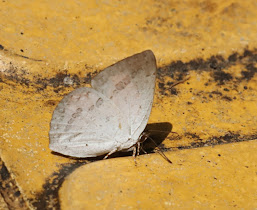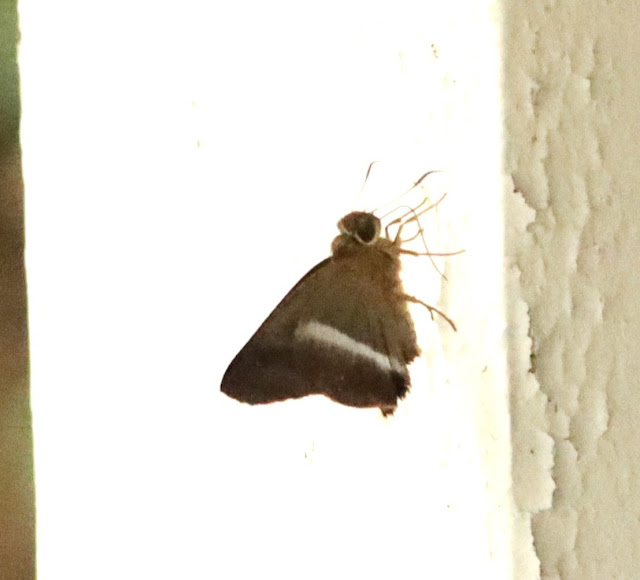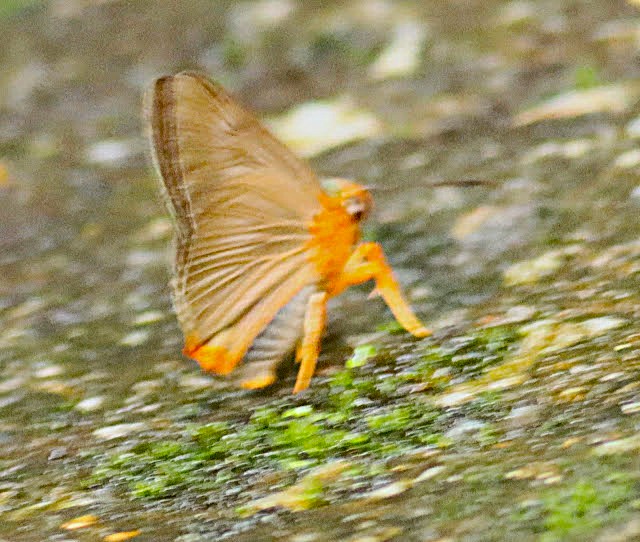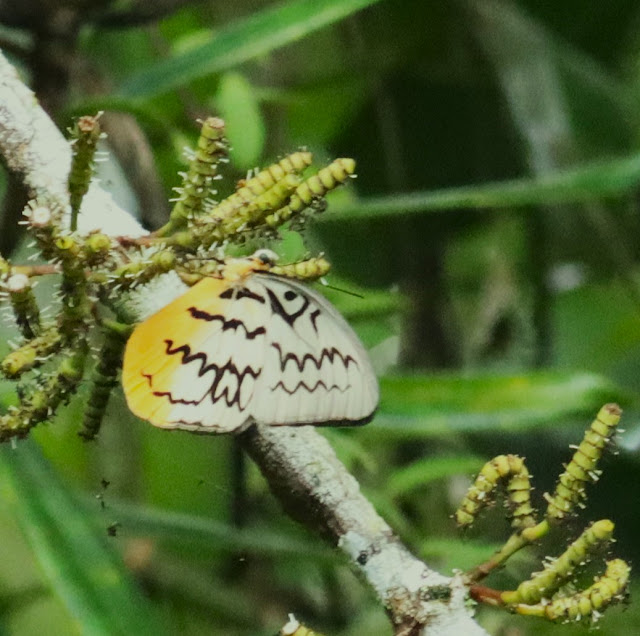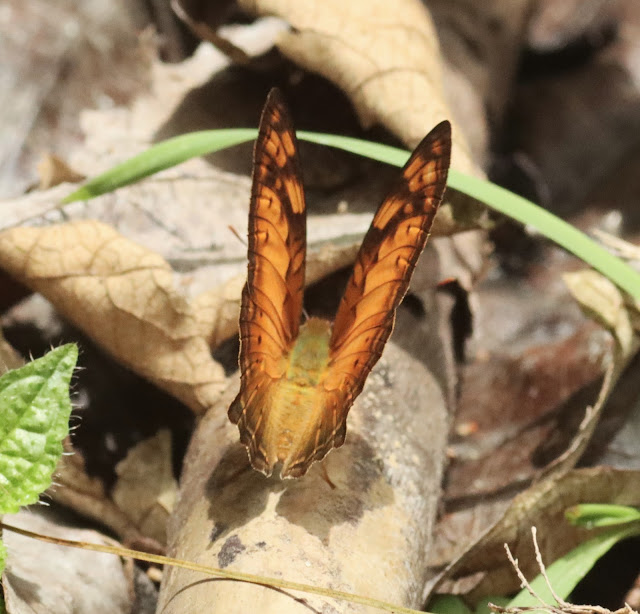Long famous for its colonial buildings which seem to stood the test of time, Fraser's Hill offers much more than just a feeling of nostalgia. At the height between 1200 meters - 1500 meters (at its highest point), Fraser's Hill is also well known among nature lovers from near and afar. Due to its height, Fraser's Hill can be considered almost a sub-montane region and has been considered a haven among birders for many years. However, it certainly has other attractions too which are seldom explored and reported. One them is the abundance of butterflies species which can be found here.
Fraser's Hill is located just about 2 hours drive from the city of Kuala Lumpur. There are no public transports going up which is a good thing to preserve the beauty of the place. So you would need to arrange your own transport to get there. The entrance to go up is shown from the above photo which is a one-way road.
Together with two other young butterfly enthusiasts, I drove up recently after a very long absence of almost 4 years. As it was a few years ago, nothing much has change. The Old Smokehouse is still there (except with their famous former chef coming back) as do its famous clock tower situated at the town centre.
We saw many flowering Lantanas at that time. However, the weather was a bit gloomy through out the day with some occasionally light drizzle. Despite the not so favourable weather for butterfly watching whereby a sunny day is much more desired, nevertheless we saw almost 30 species of butterflies within a day. Some of them were common while some were rare ones.
Sometimes you just need a steady hand and a decent handphone to take photos of a butterfly.
First up is this Black-tailed Awl (Hasora salanga).
When approach too close it would fly off but yet it will return somewhere nearby. Maybe that was its resting / roosting area.
The large brownish patch at its FW area has indeed confirmed its ID.
It was the only
Hasora Salanga we saw on that day.
We saw quite a few other Awls as well and most of them would appear in early hours of the morning and thereafter you will hardly see them again until dusk time.
Common Banded Awl
(Hasora chromus chromus)
Plain Banded Awl
(Hasora vitta vitta)
This awl is much more common and it can also be found at lower elevations like in KL.
This Awl was seen at a small hut.
I think this Awl looks like a Hasora myra funebris (edited) or commonly known as Plain-tailed Awl.
Common Orange Awlet (Edited)
(Burara jaina)
This Awlet was initially identified as a Orange Awlet (Burara harisa). It was seen earlier on our way up.
A die-hard butterfly hunter will not be afraid of rain to get a shot at this submontane species.
This a White Tiger (Danaus melanippus hegesippus)
White Tiger (Danaus melanippus hegesippus)
Probably a common species up in Fraser's Hill.
We saw quite a few sub montane species like this Horsfield's Branded Yamfly (Yasoda pitane dohertyi)
Redspot Jezebel
(Delias descombesi eranthos)
Redspot Jezebel
(Delias descombesi eranthos)
This Delias is reported to be a montane species (Kirton, 2020).
The one below is said to be much commoner in the highlands (Kirton, 2020)
Pallid Faun (Melanocyma faunula faunula)
Pallid Faun (Melanocyma faunula faunula)
This Faun was seen quite high up on a tree.
Columbine
(Stiboges nymphidia nymphidia)
Columbine
(Stiboges nymphidia nymphidia)
Kirton (2020) reported this species as a rare and localised resident of lowlands and highlands.
Yellow Spot Swift
(Zenonoida eltola corbeti)
This Swiftie (not a Taylor Swift fan unfortunately) is reported to be a rare species (CP5, 2020)
Margined-line Blue
(Prosotas pia pia)
This Prosotas is a montane species.
A comparison between two very similar looking Prosotas.
Margined-line Blue Dark-based Line Blue
(Prosotas pia pia) (Prosotas gracilis ni)
One is strictly a montane species (Prosotas pia pia) and the other one can also be found at lowlands (Prosotas gracilis ni). Both these Prosotas were seen puddling nearby to each other.
Vagrant
(Vagrans sinha sinha)

Vagrant
(Vagrans sinha sinha)
It is described as a restless butterfly by Kirton (2020) which is very true.

Vagrant
(Vagrans sinha sinha)
Then it became a bit more friendly.
Vagrant
(Vagrans sinha sinha)
It was seen near Pine Tree Trail.

Vagrant
(Vagrans sinha sinha)
A lowland to highlands species (Kirton, 2020).
Common Mapwing
(Cyretis maenalis martini)
This Mapwing is a highland resident.
Smaller Wood Nymph
(Ideopsis gaura perakana)
It is more often seen at higher elevations than at lowlands.
Malayan Punchinello
(Zemeros emesoides)
Not surprise to see this one here.
Common Batwing
(Atrophaneura varuna varuna)
Although it glided slowly but due to the weather outlook, this is the only 'decent' shot I could gather.
Here comes the big ones.
Banded Swallow Tail
(Papilio demolion demolion)
Black and White Helen
(Papilio nephelus sunatus)
Probably a female.
Here is Malaysia's very own national butterfly
Rajah Brooke's Birdwing
(Trogonoptera brookiana albescens)
Occasionally you can find one flying around in a forest trail.
Rajah Brooke's Birdwing
(Trogonoptera brookiana albescens)
Its beauty is beyond words and it's a protected species in Malaysia.
Rajah Brooke's Birdwing
(Trogonoptera brookiana albescens)
This should be a male.
Mountain Birdwing
(Troides cuneifera paeninsulae)
As its common name suggests, this is most likely a montane species.
Mountain Birdwing
(Troides cuneifera paeninsulae)
This birdwing is reported to be rarer than the above birdwings (CP5, 2020)
We found this severely tattered butterfly which I took down and place it on my curry leaf plant (Murraya koeniggii). The next day it was still there in the morning and then it flew away once the sun came out.
Purple Duke
(Eulaceura osteria kumana)
If you wish to know more about butterflies in Peninsular Malaysia, you can write your comments here.
UNTIL THE NEXT TRIP, HAVE FUN WITH THE BUTTERFLIES !!





















